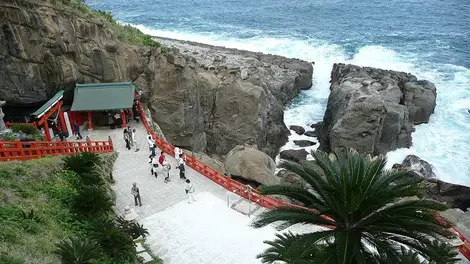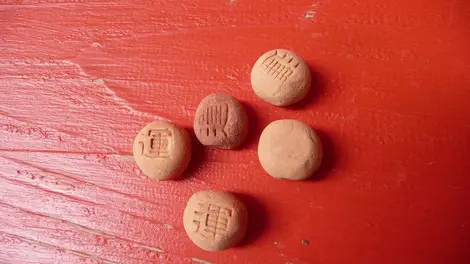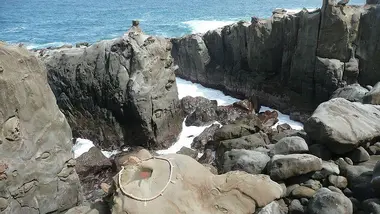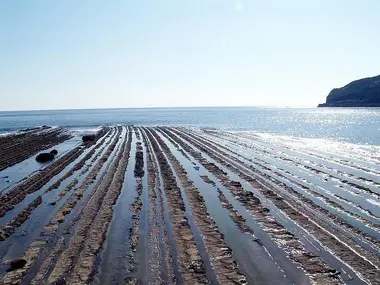Udo-jingu 鵜戸神宮
The sanctuary under the cave
During a visit to the Udo-jingu coastal sanctuary in Nichinan, immerse yourself in one of the founding myths of the archipelago. In addition, the landscape is exceptional.
The beginnings of a nation
Rare are the places whose beauty lets think that they are the fruit of a divine intervention. Nestled in a cave at the bottom of a steep cliff, the Udo-jingu Shinto shrine in Nichinan is one of them. In addition to a landscape with an incredible chromatic palette and a unique view of the ocean , Udo-jingu is of particular importance with regard to the history of the Japanese nation . The shrine, founded in 1711, is dedicated to Ugayafukiaezu, the father of Emperor Jinmu (711-585 BC), the first emperor of the archipelago and founder of the Japanese empire on February 11, 660 BC. .-C. Ugayafukiaezu is the son of the hunter Hoori and Otohime, the daughter of the god of the seas. Ugayafukiaezu owes his name, which means "unfinished cormorant feather stubble", to the story of his birth .
To read: Japan's founding day
A sea monster under a feather roof
His father, Hoori , is one day forced to fetch the lost hook of his brother, the fisherman Hoderi, from the bottom of the ocean. There he meets Otohime whom he marries immediately. After three years spent at the bottom of the sea, the couple returns to dry land for the birth of their child. It is in a cave, sheltered under the hut of which they did not have time to entirely realize the roof in feathers of cormorants that Otohime is on the point of giving birth. She warns her husband. Under no circumstances should he watch her give birth. But, intrigued, Hoori breaks his promise and sneaks out to witness the birth. Alas, he took it very badly. Hoori screams in horror upon discovering that Otohime has reverted to his original form of wani , a fearsome sea monster . Furious, Otohime throws herself into the ocean forever abandoning Hoori and her newborn child.
The feeder cave
A rare fact to report, you reach the Udo-jingu by taking the coastal access path and the stairs that go down to the bottom of the cliff ; where usually the pilgrim climbs steps to access the honden . Enthroned under a 1000 m² cave, the latter in a dazzling vermilion red offers a striking contrast with the rock and the relative darkness of the place. This sacred place where young women come to make a fertility wish is classified as Tangible Cultural Asset of the prefecture.
This power of fertility attributed to the Udo-jingu originates at the very end of the story of the birth of Ugayafukiaezu. Indeed, before leaving his child, Otohime took care to cut his chest and fix it to the wall of the cave so that his son could benefit from breast milk. Two protuberances in the stone are thus indicated as being the breasts of Otohime. From these stones called ochiwa continues to flow a milky water, used to make small candies.
See also: 5 famous Japanese legends
Very strange rocks
Another sign of the passage of Otohime is visible at the foot of the cliff. The turtle that was sent to her for childbirth from the Sea Kingdom turned into a stone statue. Its carapace has a cavity surrounded by a rope. If you manage to throw an undama (a small ball of clay marked with the kanji "luck") into this small hole, you will ensure good fortune. According to tradition, women throw the ball with their right hand and men with their left hand. During the walk, take a look at the Udo Senjojiki, a very curious rock formation to the west of the site nicknamed the "demon's washboard". An entire program !
To go further: Meoto Iwa, the married rocks of Futami
Address, timetable & access
Address
Phone
+81 987-29-1001Timetable
From Miyazaki station, take the bus towards Nichinan and get off at the Udo-jingu stop (1h10 journey)Price
FreeAccess
April to September: 6 a.m. to 7 p.m. October to March: 7 a.m. to 6 p.m.Website
http://www.udojingu.com/























